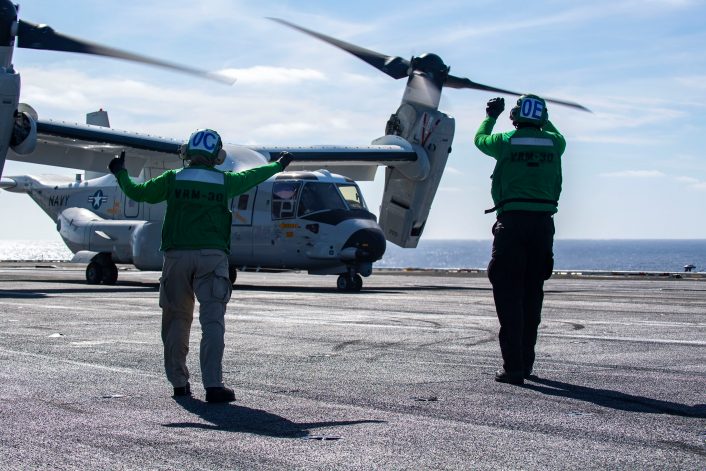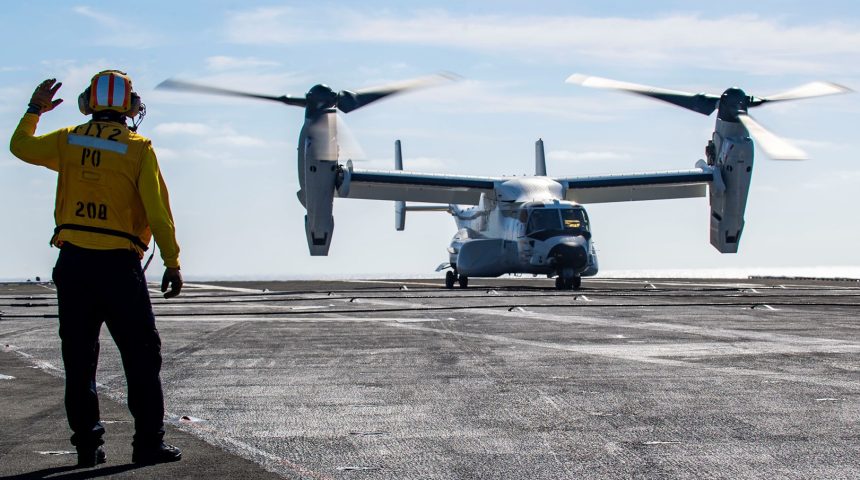For first time, a new CMV-22B Osprey carried out landings and take-offs from the flight deck of an aircraft carrier.
On Nov. 22, 2020, a CMV-22B tilt-rotor aircraft of the “Titans” of Fleet Logistics Multi-Mission Squadron (VRM) 30, conducted the first ever Navy COD (Carrier On-board Delivery) variant of the Osprey landings and take-offs from an aircraft carrier.
The CMV-22B registration #169437, assigned to Fleet Logistics Multi-Mission Squadron 30 (VRM-30) “Titans” at Naval Air Station North Island, carried out the first landing on the flight deck of USS Carl Vinson.
Another CMV-22B, registration #169440, also landed aboard the flattop, becoming the first Navy Osprey to be refueled aboard a carrier.
Actual integration of the Osprey with USS Carl Vinson (CVN-70) in preparation for the COD transition from the C-2 Greyhound started in 2016 with an MV-22 from the Marine Operational Test and Evaluation Squadron (VMX) 1 that performed landings and take-offs on the the ship during a command assessment of readiness and training (CARAT) II basic training event.
As reported in details here at The Aviationist, the CMV-22B is the specialized version of the Osprey developed from the MV-22 configuration to replace the ageing C-2 Greyhound in the COD role to transport supplies from shore bases to aircraft carriers at sea.

Whereas the C-2 Greyhound requires a trap landing on the flight deck and a catapult launch to get on and off a flattop, the Osprey can land vertically, just like a helicopter, meaning it can land on any ship’s flight deck that is strong enough to support the weight and heat of the aircraft. Moreover, its footprint on the always crowded deck is reduced if compared to that of a C-2. Finally, the CMV-22B is technically capable of moving goods and people around the entire strike group as needed, compared to the Greyhound, which can only make deliveries between the shore and the carrier.
The aircraft will feature many improvements over the Greyhound, as described by the U.S. Navy in occasion of the delivery of the first test aircraft:
“The CMV-22B will be capable of transporting up to 6,000 pounds of cargo and/or personnel over a 1,150 nautical mile range. This expanded range is due to the addition of two new 60 gallon tanks installed in the wing for an additional 120 gallons of fuel and the forward sponson tanks were redesigned for additional capacity. The CMV-22B variant has a beyond line-of-sight high frequency radio, a public address system for passengers, and an improved lighting system for cargo loading. The aircraft will also be capable of internally transporting the F-35C Lightning II engine power module.”
The Navy plans to procure 44 aircraft, with initial operational capability in 2021, according to Naval Air Systems Command.
The Titans are preparing for the first operational deployment aboard USS Carl Vinson next year to support the maiden deployment of the F-35C.









